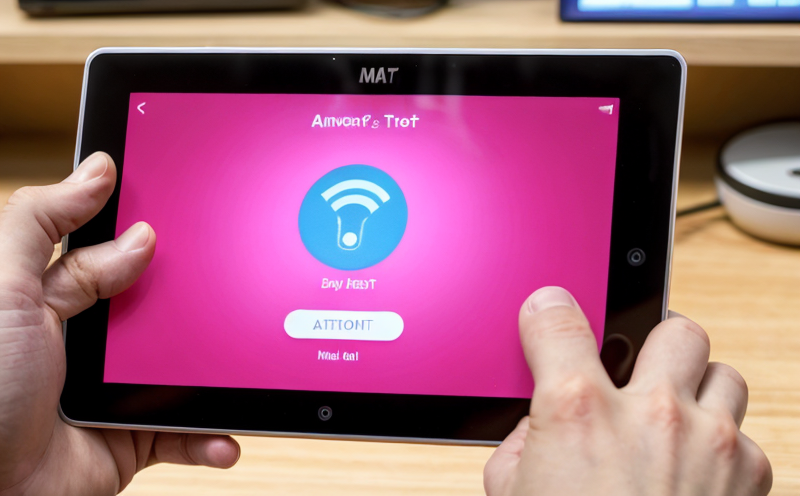Compatibility Testing with Mobile Apps
Compatibility testing is a critical component of ensuring that smart and connected consumer devices (IoT) function seamlessly across various platforms, networks, and user interfaces. For quality managers and compliance officers responsible for product safety and functionality, this service ensures that the mobile apps associated with these devices are robust and reliable in real-world conditions. This section will delve into what compatibility testing entails, why it is essential, its applications, and how it is conducted.
Compatibility testing encompasses a wide range of scenarios where IoT devices interact with various mobile platforms such as Android, iOS, Windows, and others. The goal is to ensure that the device and app work flawlessly together under different network conditions, screen sizes, and user inputs. This involves rigorous testing across multiple factors including:
- Network performance
- Data exchange protocols
- User interface interactions
- Power consumption
- Data privacy and security
The process of compatibility testing is designed to identify any potential issues that could arise when the device connects with a mobile app. This includes ensuring that the device can handle various network conditions, from high-speed Wi-Fi to slower cellular networks. It also involves verifying that the app can adapt to different screen sizes and resolutions, which are common in today’s diverse smartphone ecosystem.
The importance of this testing cannot be overstated. In a world where IoT devices are rapidly becoming more integrated into daily life, any failure in compatibility could lead to safety hazards or significant financial losses. For instance, a smart thermostat that fails to connect with its mobile app during winter months could result in higher energy bills and discomfort for users.
Additionally, compliance officers must ensure that their products meet the stringent requirements set by international standards such as ISO/IEC 27001 for information security management systems. Compatibility testing helps organizations adhere to these standards, thereby ensuring product safety and reliability.
Why It Matters
Compatibility testing with mobile apps is more than just a technical requirement; it is essential for the overall success of smart and connected consumer devices. Here’s why this service is critical:
- User Experience Enhancement: Ensuring seamless integration between IoT devices and their associated mobile apps enhances user experience, leading to higher customer satisfaction.
- Safety Compliance: By adhering to international standards like ISO/IEC 27001, organizations can demonstrate their commitment to safety and data privacy.
- Market Competitiveness: Products that perform consistently across different platforms are more likely to gain market acceptance and loyalty from consumers.
- Reduced Risk of Product Recall: Early identification of compatibility issues through rigorous testing reduces the risk of product recalls, which can be costly and damaging to a company's reputation.
In today’s competitive market, where consumer expectations are high and technology evolves rapidly, companies must prioritize the quality and reliability of their products. Compatibility testing plays a vital role in this effort by ensuring that IoT devices and their associated mobile apps work together flawlessly across various platforms and networks.
Industry Applications
The importance of compatibility testing with mobile apps extends beyond just the consumer electronics sector. This service is applicable to a wide range of industries where IoT devices are integral, including:
- Healthcare: Compatibility between medical devices and their associated apps ensures accurate data collection and efficient patient care.
- Automotive: Ensuring that infotainment systems in vehicles can seamlessly connect with mobile apps enhances user experience and safety.
- Smart Home: Devices like smart locks, thermostats, and lighting systems must work flawlessly with their associated mobile apps to ensure convenience and security.
In each of these industries, compatibility testing is crucial for ensuring that devices not only function as intended but also integrate seamlessly into the broader ecosystem. This ensures that users can enjoy a consistent experience across different platforms and networks.
Use Cases and Application Examples
| Device Type | Mobile Platform | Description of Test |
|---|---|---|
| Smartherm Thermostat | Android, iOS | Testing the thermostat’s ability to connect with its mobile app across different Wi-Fi networks and ensure accurate temperature control. |
| Smart Door Lock | Windows | Evaluating the door lock's compatibility with Windows-based smartphones to ensure secure access. |
| Smart TV Set Top Box | iOS, Android | Ensuring that the set top box can stream content seamlessly with mobile apps on different platforms. |
- Smartherm Thermostat: This device needs to connect reliably with its mobile app across various Wi-Fi networks. The test checks for accurate temperature readings and control functions, ensuring the user can manage their home environment effectively.
- Smart Door Lock: Compatibility testing ensures that the door lock works securely with Windows-based smartphones, allowing users to grant access remotely and monitor usage.
- Smart TV Set Top Box: This device must stream content flawlessly across different platforms, ensuring a smooth user experience for watching movies or live broadcasts.
These examples highlight the diverse applications of compatibility testing in IoT devices. By ensuring that these devices work seamlessly with mobile apps, companies can enhance user satisfaction and trust, leading to greater market success.





